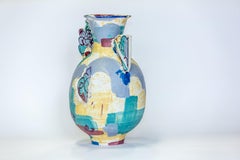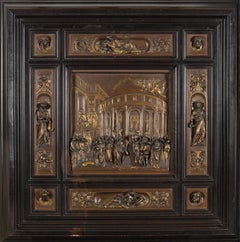Old Masters Still-life Sculptures
Recent Sales
After Alhambra', large, lilac, turquoise and royal blue , 2021, Amy Hughes
By Amy Hughes
Located in London, GB
AMY HUGHES
After Alhambra', large, lilac, turquoise and royal blue , 2021
Coil and slab built vase; grogged stoneware body with high fired porcelain and coloured decorating slips, transparent glaze interior detail.
53 x 40 cm
20 3/4 x 15 3/4 in.
(AH013)
Amy Hughes has a fascination with vases, largely fuelled by the 18th century, resulting in collections which aim to bridge the gap between the past and the present, finding a new home in contemporary culture for such objects creating a ‘modern decadence’, whilst paying homage to and referencing the originals. Learning from the past; skills used and traditions taught, is fundamental to her as a practitioner.
Her practice is both fuelled by and symbolic of the highly prestigious Porcelain wares produced at the Royal Sèvres Factory in the late 17th and 18th centuries. Hughes’ works reference and pay homage to the originals, but are created with a freer approach, giving them a new lease of life.
After Alhambra pieces take inspiration from the large lustre vases produced during the Nasrid Dynasty (the last Muslim Dynasty in the Iberian peninsula, ruling Granada) in the 14th and 15th centuries which became romantically known as 'Alhambra Vases...
Category
2010s Old Masters Still-life Sculptures
Materials
Porcelain, Glaze
The Story of Joseph after Lorenzo Ghiberti's “Gates of Paradise, " Florence
Located in New York, NY
Ferdinand Barbedienne
(Saint-Martin-de-Fresnay 1810 – 1892 Paris)
after Lorenzo Ghiberti
(Florence, 1378 – 1455)
The Story of Joseph from the Second Baptistery Doors,
Florence (“The Gates of Paradise”)
Signed at the lower right of the principal relief: F. BARBEDIENNE FONDEUR
Nine bronze reliefs set into a wooden frame
27 ½ x 27 ½ inches (70 x 70 cm)
The present work is a half-size reduction of nine panels from the famous Gates of Paradise by Lorenzo Ghiberti, made for the Baptistery of Florence and now housed in the Museo del Opera del Duomo. The central scene is one of the most remarkable, The Story of Joseph, comprised of seven episodes from the Biblical narrative integrated into one composition: Joseph cast by his brethren into the well, Joseph sold to the merchants, the merchants delivering Joseph to the pharaoh, Joseph interpreting the pharaoh’s dream, the pharaoh paying him honor, Jacob sending his sons to Egypt, and Joseph recognizes his brothers and returns home. The surrounding reliefs—two vertical figures in niches, two recumbent figures, and four portrait heads in roundels—are as well faithful reductions of Ghiberti’s original bronzes on other parts of the doors.
The maker of these casts was the renowned 19th-century French fondeur Ferdinand Barbedienne. Gary Radke has recently written of this great enterprise:
“The Parisian bronze caster Ferdinand Barbedienne began making half-sized copies of ancient and Renaissance sculpture in the 1830s. His firm benefitted enormously from the collaboration of Achille Collas, whom Meredith Shedd has shown was one of numerous pioneers in the mechanical reproduction of sculpture. Their competitors largely devoted themselves to reproducing relief sculpture, but Collas devised a process for creating fully three-dimensional copies. A tracing needle, powered by a treadle, moved over the surface of a full-sized plaster cast or bronze of the original and triggered a complementary action in a cutting stylus set over a soft plaster blank…He signed an exclusive contract with Barbedienne on November 29, 1838, and won medals for his inventions in 1839 and 1844.
Barbedienne’s half-sized copies of the Gates of Paradise were famous not only for their fidelity to the original, but also for the way their gilding…suggested the glimmering surface that was hidden under centuries of dirt. Some critics even saw Collas’s and Barbedienne’s work as ‘philanthropic, an exemplary adaptation of industry to the requirements of art, the artist, the workers, and the public alike.’
At 25,000 francs, Collas’s and Barbedienne’s reduction of the Gates of Paradise was singularly more expensive than any other item for sale in their shop. All the reliefs, individual statuettes, and busts were cast separately and could be purchased either by the piece or as an ensemble. Fittingly, Barbedienne’s accomplishment earned him the Grand Prix at the 1878 Paris Exposition Universelle, along with numerous other medals.”
Only two complete examples of the Barbedienne-Ghiberti doors are known. One, first installed in a chapel in the Villa Demidoff of San Donato near Pratolino, was later acquired by William Vanderbilt...
Category
19th Century Old Masters Still-life Sculptures
Materials
Bronze

